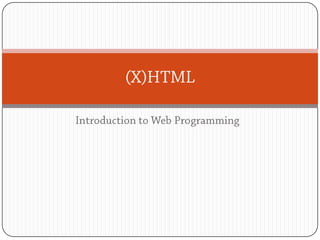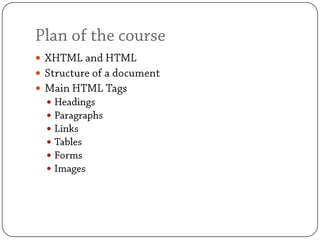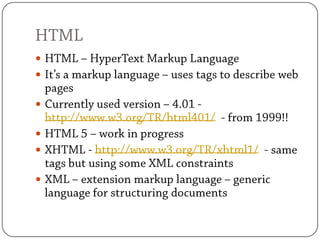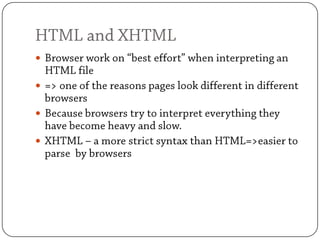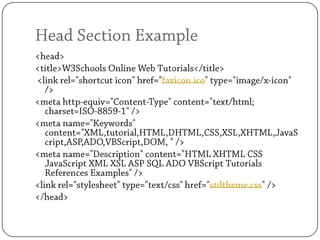IPW HTML course
- 1. Introduction to Web Programming(X)HTML
- 2. Plan of the courseXHTML and HTML Structure of a documentMain HTML TagsHeadingsParagraphsLinksTablesFormsImages
- 3. HTMLHTML â HyperText Markup LanguageItâs a markup language â uses tags to describe web pagesCurrently used version â 4.01 - http://www.w3.org/TR/html401/ - from 1999!!HTML 5 â work in progressXHTML - http://www.w3.org/TR/xhtml1/ - same tags but using some XML constraintsXML â extension markup language â generic language for structuring documents
- 4. What is a html tagKeywords between â<â and â>âThere is usually a start tag and an end tagexample:<tag>âĶ</tag>Empty tags<tag />AttributesAn attribute is a pair of type name=âvalueâ that is inside a tag<tag attribute=âvalueâ> âĶ </tag>
- 5. Characteristics of tagsTags should always be closed â/>âbe written in lowercaseBe properly nested<tag1><tag2></tag2></tag1><tag1><tag2></tag1></tag2>
- 6. HTML and XHTMLBrowser work on âbest effortâ when interpreting an HTML file=> one of the reasons pages look different in different browsersBecause browsers try to interpret everything they have become heavy and slow.XHTML â a more strict syntax than HTML=>easier to parse by browsers
- 7. Structure of a documentLogical structure of a documentTitle of the document Titles of the different sectionsContent Paragraphs, quoted text, codeTabular informationLists of items (ordered or unordered)Very short example of document structure using Word
- 8. Structure of an XHTML Document<html> <head> <title>the title of the document</title> </head> <body> <!-- the content of the document --> </body></html>
- 9. The head sectionContains data about the document<title> - the actual document title â appears in the browser bar<link> - points to a resource used by the page (<link rel="shortcut icon" href="/favicon1.ico" type="image/x-icon" />)<meta> - defines meta information like keywords, content type, description â used by browsers and by spiders<script> - contains references to scripts
- 10. Head Section Example<head> <title>W3Schools Online Web Tutorials</title><link rel="shortcut icon" href="favicon1.ico" type="image/x-icon" /> <meta http-equiv="Content-Type" content="text/html; charset=ISO-8859-1" /> <meta name="Keywords" content="XML,tutorial,HTML,DHTML,CSS,XSL,XHTML,JavaScript,ASP,ADO,VBScript,DOM, " /> <meta name="Description" content="HTML XHTML CSS JavaScript XML XSL ASP SQL ADO VBScript Tutorials References Examples" /> <link rel="stylesheet" type="text/css" href="stdtheme.css" /> </head>
- 11. The body sectionContains the tags that are displayed in the browserThe body section SHOULD contain the contentThe style information should be placed in external documents (see next course)Elements are going to be presented next and weâre going to build a web page adding each element step by step
- 12. HeadingsThe titles of the sectionsH1âĶH6Used by search engines to âunderstandâ the structure of the documentSHOULD NOT be used for style reasons (make text bigger and bolder)<h1>title of document</h1><h2> title of first section</h2><h3> title of the first sub-section</h3>
- 13. Content and formatting<p>this is a paragraph</p><br/> - passes to the next line<hr> - horizontal line<em> - emphasized text<strong> - strong text<small> - small text<sub> <sup>
- 14. ListsOrdered lists (numbered, ordered with letters or roman numbers) - <ol>Unordered lists (bulleted) â <ul>Items of the list for each of the 2 types of lists - <li>Example:<ul><li>red</li><li>green</li></ul>
- 15. Links<a href=/slideshow/ipw-html-course/7098777/âabsolute or relative urlâ target=ââ>text or image</a>The target represents where the link should openMissing â the same pageâ_blankâ â new window<a name=âname of an anchor in the same document> text or image </a><a href=â#name of an anchorâ>text or image</a>
- 16. Images<img src=/slideshow/ipw-html-course/7098777/âabsolute or relative urlâ alt=âalternative text in case the image canât be displayed or canât be understoodâ/>The âaltâ attribute is mandatory in XHTML! the src can be a full url: http://host/path_to_file or a path relative to the current page.
- 17. TablesTables should ONLY be used for presenting tabular informationThey should not be used for design<table><tr> <!--table row) --><td > table cell</td></tr></table>
- 18. Tablescolspanused to have a cell that spans on multiple columns Attribute of the td elementrowspanused to have a cell span on multiple rowsAttribute of the td elementBorder If the table has a border or notAttribute of the table element
- 19. Tables example<table border="1"> <tr> <td> </td> <td> </td> <td> </td> <td> </td> </tr> <tr> <td> </td> <td> </td> <td> </td> <td> </td> </tr> <tr> <td> </td> <td> </td> <td> </td> <td> </td> </tr> </table><table border="1"> <tr> <td colspan="2"> </td><!-- only 3 cells because 1 spans on 2 columns--> <td> </td> <td> </td> </tr> <tr> <td rowspan="2"> </td> <td> </td> <td> </td> <td> </td> </tr> <tr> <!-- only 3 cells because 1 above spans on 2 rows --> <td> </td> <td> </td> <td> </td> </tr> </table>
- 20. FormsNecessary to collect and submit data to the server<form action=âthe server script that handles the submitted dataâ method=âthe HTTP request method â GET or POSTâ>A form contains different kinds of input
- 21. Form InputsText input <input type=âtextâ name=ââ />Checkbox <input type=âcheckboxâ name=ââ value=ââ/>Radio <input type=âradioâ name=ââ value=ââ/>Text area <textarea name=ââ></textarea>Submit <input type=âsubmitâ value=âname on the buttonâ/>
- 22. Form example<form method="post" action="script.php"> Username: <input type="text" name="username" /><br /> Password:<input type="password" name="password" /><br /> Country: <select name="country"> <option value="eng">England</option> <option value="fra">France</option> <option value="rou" selected="selected">Romania</option> </select> <br /> Address: <textarea name="address"></textarea><br /> Type of account: <ul><li>Normal <input type="radio" name="account" value="normal" /></li> <li>Special <input type="radio" name="account" value="special" /></li> </ul> Do you want to subscribe to our newsletter <input type="checkbox" name="subscription"/><br /> <input type="submit" value="Register" /> </form>
- 23. OthersHtml commentsWhenever you write code you need to write commentsï<!-- this is a comment in html -->
- 24. HTML Special CharactersSome special characters <,>,â â,& need to be represented differently in HTMLThere shouldnât be confusion between the content of the page and the syntaxThe special characters are represented like:&code;Code is usually a 3-4 letter sequence that represents the special character
- 25. HTML Special Characters& - &â â (space) - â - "< - <> - >Others:http://www.w3schools.com/tags/ref_entities.asphttp://www.w3schools.com/tags/ref_symbols.asp
- 26. ConclusionsIn this course there are only the most important tags; more of them can be discovered as you work HTML should be used for presenting content in web pagesThe tags should be used according to their semantics

